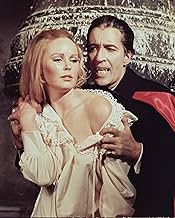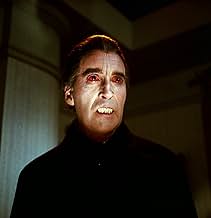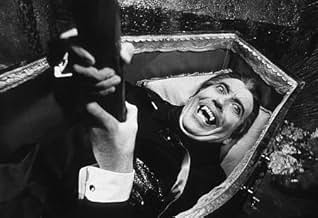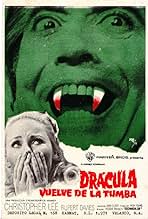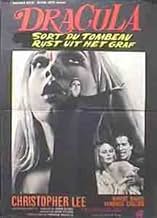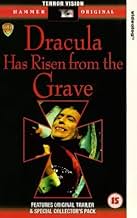VALUTAZIONE IMDb
6,5/10
8690
LA TUA VALUTAZIONE
Aggiungi una trama nella tua linguaAfter a Monsignor accidentally brings Count Dracula back from the dead while exorcising his castle, the vampire preys on the holy man's beautiful niece and her friends.After a Monsignor accidentally brings Count Dracula back from the dead while exorcising his castle, the vampire preys on the holy man's beautiful niece and her friends.After a Monsignor accidentally brings Count Dracula back from the dead while exorcising his castle, the vampire preys on the holy man's beautiful niece and her friends.
- Regia
- Sceneggiatura
- Star
- Premi
- 1 candidatura in totale
Christopher Cunningham
- Farmer
- (as Chris Cunningham)
Carrie Baker
- First victim
- (non citato nei titoli originali)
Donald Campbell
- Tavern Customer
- (non citato nei titoli originali)
Frank Forsyth
- Villager
- (non citato nei titoli originali)
Lindsay Hooper
- Tavern Customer
- (non citato nei titoli originali)
Philip Stewart
- Tavern Customer
- (non citato nei titoli originali)
John Timberlake
- Tavern Customer
- (non citato nei titoli originali)
Recensioni in evidenza
One year after destroying Dracula (Christopher Lee), Monsignor (Rupert Davies) returns to his castle in the mountains with the local priest (Ewan Hooper) to exorcise his castle. However, the priest accidentally resurrects Dracula and becomes his slave. Meanwhile Monsignor returns home in Keinenberg on the day of the birthday of his niece Maria (Veronica Carlson), who lives with her mother Anna (Marion Mathie) in his house. Maria is in love with the atheist Paul (Barry Andrews), who works with the waitress Zena (Barbara Ewing) in the bar owned by his friend Max (Michael Ripper) where he also lives. Dracula decides to revenge on Monsignor and travels with the priest to Keinenberg. What will Dracula do next?
"Dracula Has Risen from the Grave" is the third film by Hammer featuring Christopher Lee in the role of Dracula. The film is still interesting almost fifty years later for fans of Dracula, but there are better ones. Paul staking Dracula that does not die because Paul does not pray is totally weird. My vote is six.
Title (Brazil): "Drácula, o Perfil do Diabo" ("Dracula, The Profile of the Devil")
"Dracula Has Risen from the Grave" is the third film by Hammer featuring Christopher Lee in the role of Dracula. The film is still interesting almost fifty years later for fans of Dracula, but there are better ones. Paul staking Dracula that does not die because Paul does not pray is totally weird. My vote is six.
Title (Brazil): "Drácula, o Perfil do Diabo" ("Dracula, The Profile of the Devil")
A weak script doesn't hinder "Dracula Has Risen from the Grave" from being absorbing most of the way. It has a weak mid-section full of repetitious scenes of Dracula about to take a bite out of a voluptuous female, scenes that don't advance the plot the way they should.
For this reason, some may find fault with the slow pace of much of the film but there's no denying the impressive look of sets, costumes and the proper Gothic atmosphere. Technicolor captures every bit of the shadows and light, just the way effective B&W photography has always done in the past. And the close-ups of Christopher Lee's bloodshot eyes lingers in the mind long after his infrequent appearance has been made.
That's also part of the problem. The role of Dracula really takes a back seat to others in the cast, all of whom are competent performers. Particularly engaging are Veronica Carlson (as one of Dracula's most sought after victims) and Barry Andrews as her infatuated boyfriend. Andrews plays the role of Paul with a saucy cockiness and a twinkle in his eye, easily making what is essentially a cardboard role a standout among the supporting players by virtue of his earnest performance and personality.
Engaging enough as a typical Dracula thriller, but clearly not the best of the Hammer films in this series. James Bernard's music helps keep the suspense level vibrant enough.
For this reason, some may find fault with the slow pace of much of the film but there's no denying the impressive look of sets, costumes and the proper Gothic atmosphere. Technicolor captures every bit of the shadows and light, just the way effective B&W photography has always done in the past. And the close-ups of Christopher Lee's bloodshot eyes lingers in the mind long after his infrequent appearance has been made.
That's also part of the problem. The role of Dracula really takes a back seat to others in the cast, all of whom are competent performers. Particularly engaging are Veronica Carlson (as one of Dracula's most sought after victims) and Barry Andrews as her infatuated boyfriend. Andrews plays the role of Paul with a saucy cockiness and a twinkle in his eye, easily making what is essentially a cardboard role a standout among the supporting players by virtue of his earnest performance and personality.
Engaging enough as a typical Dracula thriller, but clearly not the best of the Hammer films in this series. James Bernard's music helps keep the suspense level vibrant enough.
Released in the USA in the Winter of 1969, Hammer's "Dracula has Risen from the Grave" was the fourth entry in the series and the third with Christopher Lee in the title role. Here's a list of the nine films for those interested:
Horror of Dracula (1958); The Brides of Dracula (1960); Dracula: Prince of Darkness (1966); Dracula Has Risen from the Grave (1968); Taste the Blood of Dracula (1969); Scars of Dracula (1970); Dracula AD 1972 (1972); The Satanic Rites of Dracula (1973); and The Legend of the 7 Golden Vampires (1974).
"Dracula has Risen from the Grave" suffers from a weak prologue and first act. The prologue takes place a year prior to the main story. The first act involves two priests hiking up to Dracula's castle to exorcise it. One of the priests unwittingly resurrects the count and the vampire wants revenge on the other priest whom he discovers blessed his abode. The final hour involves Dracula going after his niece in a neighboring village. The niece's boyfriend and the priest must defend her.
Like I said, the whole first act isn't very promising, but things perk up with the introduction of the niece's boyfriend, Paul, and the pub his dad runs. Barbara Ewing plays Zena, the redhead waitress at the pub, and the film shows the close relationships between Paul, his father and Zena. The characters ring true and it draws the viewer into their world. Excellent job on this front.
A great scene takes place when Paul's girlfriend, Maria (played by the stunning Veronica Carlson), takes Paul to her home to introduce him to her mother and the priest, who's a Monsignor (whatever that is). Paul is cornered in a conversation and forced to reveal that he doesn't believe in God. The Monsignor is initially offended and rude, but this can be excused on the grounds that he's the father-figure to his beloved niece; besides there's a warmhearted scene later in the film where the Monsignor proves his loving nature.
Another unusual highlight of the film are the multiple scenes that take place on the labyrinthian rooftops of the Victorian village. I can't help but wonder how they accomplished this. Were they really filming on the rooftops of a village or is it an illusion accomplished through matte paintings or other effects? I'm sure it's the latter; regardless, it's excellent film work and a unique feature of this film.
Of course, Hammer films are renown for their curvaceous women and here we have two: Redhead Barbara Ewing as the very likable Zena, and Veronica Carlson, who can also be seen in the outstanding "Frankenstein Must Be Destroyed".
As with most of Hammer's horror flicks, the movie possesses a beautifully lush, Gothic atmosphere.
Despite the weak first act, the positives noted above compel me place "Dracula has Risen from the Grave" as my second or third favorite of the series. My favorite being "Taste the Blood of Dracula."
The film runs 92 minutes and was shot at Pinewood Studios, Buckinghamshire, England.
GRADE: B
Horror of Dracula (1958); The Brides of Dracula (1960); Dracula: Prince of Darkness (1966); Dracula Has Risen from the Grave (1968); Taste the Blood of Dracula (1969); Scars of Dracula (1970); Dracula AD 1972 (1972); The Satanic Rites of Dracula (1973); and The Legend of the 7 Golden Vampires (1974).
"Dracula has Risen from the Grave" suffers from a weak prologue and first act. The prologue takes place a year prior to the main story. The first act involves two priests hiking up to Dracula's castle to exorcise it. One of the priests unwittingly resurrects the count and the vampire wants revenge on the other priest whom he discovers blessed his abode. The final hour involves Dracula going after his niece in a neighboring village. The niece's boyfriend and the priest must defend her.
Like I said, the whole first act isn't very promising, but things perk up with the introduction of the niece's boyfriend, Paul, and the pub his dad runs. Barbara Ewing plays Zena, the redhead waitress at the pub, and the film shows the close relationships between Paul, his father and Zena. The characters ring true and it draws the viewer into their world. Excellent job on this front.
A great scene takes place when Paul's girlfriend, Maria (played by the stunning Veronica Carlson), takes Paul to her home to introduce him to her mother and the priest, who's a Monsignor (whatever that is). Paul is cornered in a conversation and forced to reveal that he doesn't believe in God. The Monsignor is initially offended and rude, but this can be excused on the grounds that he's the father-figure to his beloved niece; besides there's a warmhearted scene later in the film where the Monsignor proves his loving nature.
Another unusual highlight of the film are the multiple scenes that take place on the labyrinthian rooftops of the Victorian village. I can't help but wonder how they accomplished this. Were they really filming on the rooftops of a village or is it an illusion accomplished through matte paintings or other effects? I'm sure it's the latter; regardless, it's excellent film work and a unique feature of this film.
Of course, Hammer films are renown for their curvaceous women and here we have two: Redhead Barbara Ewing as the very likable Zena, and Veronica Carlson, who can also be seen in the outstanding "Frankenstein Must Be Destroyed".
As with most of Hammer's horror flicks, the movie possesses a beautifully lush, Gothic atmosphere.
Despite the weak first act, the positives noted above compel me place "Dracula has Risen from the Grave" as my second or third favorite of the series. My favorite being "Taste the Blood of Dracula."
The film runs 92 minutes and was shot at Pinewood Studios, Buckinghamshire, England.
GRADE: B
Sporting the ultra camp title - "Dracula Has Risen From the Grave", this is a solid entry in Hammer's Dracula series. What I love about Hammer is that they aren't afraid to take an existing story and play around with it to create something new. Even if the idea behind is less than brilliant and most studios would have shied away, Hammer approach it with gusto, and the results are always good natured, easy viewing that's hard to dislike. This film follows Count Dracula as he is resurrected shortly after the priest, Ernst Muller, exorcises his castle. Dracula doesn't take this sort of behaviour lightly, and so decides to take on revenge on the holy man - by taking his niece as his bride!
Dracula is one of the greatest characters ever to be written and portrayed on screen, and it's also one that Christopher Lee has become famous for playing. Unfortunately, Christopher Lee doesn't have a great deal of screen time in this flick; but every moment he is on screen is a highlight and, as usual, he does well with the role and proves that he is the only man other than Bela Lugosi to do it right. Freddie Francis (Dr Terror, The Creeping Flesh) directs this film and succeeds in creating a morbid and fascinating atmosphere that bodes well with the subject material on hand. The film is stylishly shot, and features some of the best use of lighting ever seen in a Hammer film. The camp style that the studio is famous for is here by the bucket load too, and that can only be a good thing. This is hardly Hammer's finest hour, however; the film is relatively slow to start, and the story isn't the most inventive ever to come from the studio - but Hammer fans will enjoy it, and I would have no qualms with recommending this as a decent waste of your time.
Dracula is one of the greatest characters ever to be written and portrayed on screen, and it's also one that Christopher Lee has become famous for playing. Unfortunately, Christopher Lee doesn't have a great deal of screen time in this flick; but every moment he is on screen is a highlight and, as usual, he does well with the role and proves that he is the only man other than Bela Lugosi to do it right. Freddie Francis (Dr Terror, The Creeping Flesh) directs this film and succeeds in creating a morbid and fascinating atmosphere that bodes well with the subject material on hand. The film is stylishly shot, and features some of the best use of lighting ever seen in a Hammer film. The camp style that the studio is famous for is here by the bucket load too, and that can only be a good thing. This is hardly Hammer's finest hour, however; the film is relatively slow to start, and the story isn't the most inventive ever to come from the studio - but Hammer fans will enjoy it, and I would have no qualms with recommending this as a decent waste of your time.
Great opening for this installment, a deaf altar boy discovers a young woman hanging upside down from the church bell, blood dripping from her neck. Move forward a year and Count Dracula is accidentally revived. He goes on his usual round of terror and bloodsucking, his target of desire being the beautiful Veronica Carlson. He certainly has great taste in women!
The sets are great, I felt like I was almost in the mountain village. Good cast, nice to see Hammer's most prolific actor Michael Ripper have a larger part than normal. No Peter Cushing here, which makes the vampire hunter aspect interesting. There is some debate within the film of faith versus atheism, apparently staking a vampire does not work if the person doing the staking lacks religious belief. Interesting.
We have no nudity but there are sexual overtones. Thankfully we get plenty of blood, plus Hammer's trademark day for night scenes and swirling fog.
Not one of the studio's best vampire movies but it's still a wonderful piece of Gothic horror, I grew up on watching these films and love immersing myself into them, over and over again.
Lo sapevi?
- QuizThis was Hammer Films' most profitable movie.
- BlooperWhen the bell-ringer arrives at the church at the beginning of the movie he leaves his bicycle on the steps of the front door. When the priest arrives and rushes to investigate the screaming, the bicycle is no longer there.
- Versioni alternativeThe UK cinema version was cut by the BBFC to remove some closeup shots of Dracula pulling a stake from his heart. Later video and DVD releases were uncut.
- ConnessioniFeatured in Una messa per Dracula (1970)
I più visti
Accedi per valutare e creare un elenco di titoli salvati per ottenere consigli personalizzati
Dettagli
- Data di uscita
- Paese di origine
- Lingue
- Celebre anche come
- Drácula vuelve de la tumba
- Luoghi delle riprese
- Azienda produttrice
- Vedi altri crediti dell’azienda su IMDbPro
- Tempo di esecuzione
- 1h 32min(92 min)
- Mix di suoni
- Proporzioni
- 1.66 : 1(original/negative ratio)
Contribuisci a questa pagina
Suggerisci una modifica o aggiungi i contenuti mancanti


